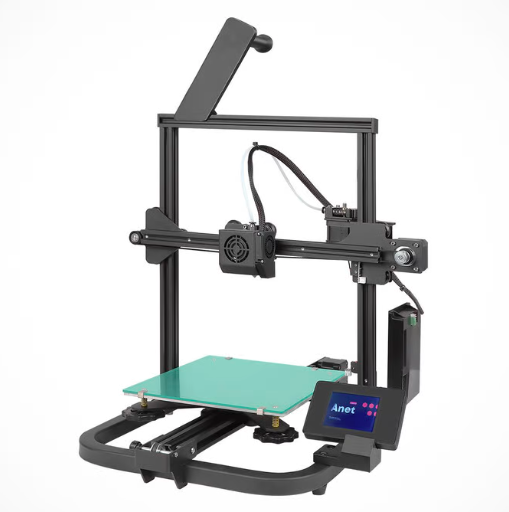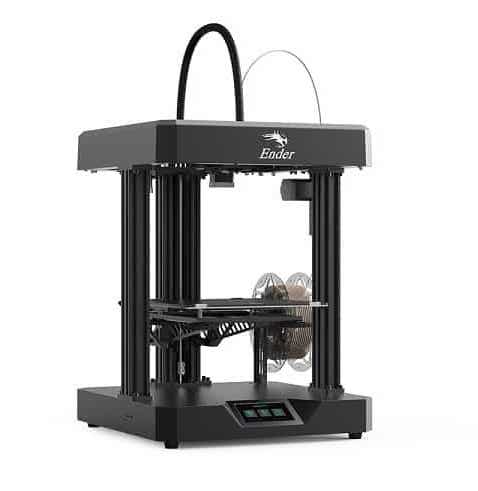Compare A8 V2 vs Ender 7
Comparison between the best 3D printers
Choose the best 3D printer at the best price. The cheapest 3D printers are here.
Buy a 3D printer here with 3D Fila.
 |
 |
|
| Model | A8 V2 |
Ender 7[BUY Ender 7] |
| Printing Material | Filament | Filament |
| Buy Filament for Anet A8 V2 | Buy Filament forCreality 3D Ender 7 | |
| Estimated price | $129,00 | $429,00 |
| Manufacturer | Anet | Creality 3D |
| Release Year | 2021 | 2021 |
| Print Volume [mm] | 220x220x250 | 250x250x300 |
| Printer Size [mm] | 428x441x486 | 430x460x570 |
| Weight [kg] | 6,2 | 17,2 |
| Power Loss Recovery | NO | YES |
| Enclosed printer | NO | NO |
| Bed Leveling | Manual | Manual |
| Filament End Sensor | NO | YES |
| Bed type | Heated | |
| Power supply system | Bowden | Bowden |
| Standard nozzle | 0,4 | 0,4 |
| Maximum Nozzle Temperature [°C] | 230 | 260 |
| Maximum Bed Temperature [°C] | 100 | |
| Maximum printing speed [mm/s] | 150 | 250 |
| Filament holder | YES | YES |
| Camera for supervision | NO | NO |
| Recommended filaments | PLA | PLA, PETG, Tritan, Flex, ABS |
| Recommended slicers | Cura, Simplify, Slic3r, IdeaMaker | Cura, Simplify, Slic3r, IdeaMaker |
| Maximum Resolution [mm] | 0,1 | 0,1 |
| Processor | Creality CR-FDM V.2.4.S1_V101 32bits | |
| Display | Display touchscreen 2,8'' | Display touchscreen 4,3'' |
| Power Supply | 110/220V / 250W | 110/220V / 350W |
| Connectivity | SD / USB | SD / USB |
| Operating systems | Windows, Mac, Linux | Windows, Mac, Linux |
| Date of registration in the system | 2022-11-10 | 2022-11-04 |
| Release date | 2021 | 2021 |
| Extra features | The Anet A8 V2 is a Cartesian-XZ type 3D printer with a build volume of 220 x 220 x 250 mm, Ender 3 design and V-slot assembly. It has a 32-bit motherboard and touchscreen interface, promising ease of use. It uses open source firmware and has thermal failure protection. It stands out for its cable organization and the absence of a heated bed, focusing on energy savings and PLA printing. It comes with an external power adapter, aiming at greater safety, especially for beginners and educational use. | Crealitys Ender 7 printer offers remarkable print speeds, utilizing CoreXY kinematics for precise and fast movement. With a 250x250x300mm build area, dual direct extruder, and custom hotend, the Ender 7 is capable of printing at high speeds, although quality may suffer on smaller prints. Assembly is relatively straightforward, but the machine is noisy and can get hot. Its true speed potential is most noticeable on larger prints, where it outperforms its competitors. |
| Support for multiple colors and materials (AMS and CFS) | NO | NO |
Notes * |
||
| Cost-benefit | 6 / 10 | 7 / 10 |
| Hardware | 0.5 / 10 | 2 / 10 |
| Tela | . | . |
| Print volume | 3 / 10 | 4 / 10 |
| Performance | 1 / 10 | 2 / 10 |
| [BUY Ender 7] |
Conclusion |
| In comparing the Anet A8 V2 and the Creality Ender 7, it's clear that both models cater to different user needs and preferences in the 3D printing space. The Anet A8 V2 is significantly more affordable and offers a basic entry-level platform that's suitable for beginners. Its smaller print volume and lack of advanced features like power loss recovery and a filament end sensor limit its capabilities, making it more appropriate for simpler projects and users who are just starting with 3D printing. However, it does come with a decent degree of safety features, such as thermal failure protection and an external power adapter. On the other hand, the Creality Ender 7, while more expensive, provides substantial advantages in terms of print speed and build volume. The CoreXY kinematics allow for faster and more precise movements, which enhances the printing experience, particularly for larger projects. It supports more materials and boasts features like a filament end sensor and power recovery, which contribute to a more reliable and advanced printing operation. Ultimately, the choice between these two printers depends on the user's budget and specific needs. If cost-effectiveness and simplicity are the primary concerns, the Anet A8 V2 serves as a competent introductory option. Conversely, for those who are willing to invest a bit more for higher speed, better performance, and expanded capabilities, the Ender 7 represents a superior choice. Thus, evaluating personal requirements and intended use will guide the decision on which 3D printer provides the best value for the investment. |

